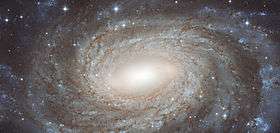NGC 6384
| NGC 6384 | |
|---|---|
|
Hubble Space Telescope image of NGC 6384 | |
| Observation data (J2000 epoch) | |
| Constellation | Ophiuchus |
| Right ascension | 17h 32m 24.302s[1] |
| Declination | +07° 03′ 36.97″[1] |
| Helio radial velocity | 1,665 km/s[2] |
| Distance | 76.6 Mly (23.5 Mpc)[2] |
| Characteristics | |
| Type | SAB(r)bc[3] |
| Mass | 1.05 × 1011[3] M☉ |
| Size | 138,000 light years |
| Other designations | |
| UGC 10891 | |
NGC 6384 is an intermediate barred spiral galaxy located about 77 million light-years away in the northern part of the constellation Ophiuchus. It has a morphological classification of SAB(r)bc,[3] indicating that it is a weakly barred galaxy (SAB) with an inner ring structure (r) orbiting the bar, and moderate to loosely wound spiral arms (bc).[4] The galaxy is inclined by an angle of 47° to the line of sight, along a position angle of 40°.[5] The estimated mass of the stars in this galaxy is 105 billion times the mass of the Sun.[3]
At one time NGC 6384 was considered a normal galaxy with no activity in the nucleus. However, it is now classified as a transition object (T2), which is thought to be a LINER-type galaxy whose emission-line spectra is contaminated by H II regions in the nucleus.[6]
On 24 June 1971, a type Ia supernova event was discovered in this galaxy at 27″ east and 20″ north of the nucleus. It reached a peak visual magnitude of 12.85 around the end of June.[7] Designated SN 1971L, it was situated along a spiral arm, suggesting that the progenitor was not a member of the older, more evolved stellar population of the galaxy.[5]
References
- 1 2 Skrutskie, M. F.; et al. (February 2006), "The Two Micron All Sky Survey (2MASS)", The Astronomical Journal, 131 (2): 1163–1183, Bibcode:2006AJ....131.1163S, doi:10.1086/498708.
- 1 2 Cappellari, Michele; et al. (May 2011), "The ATLAS3D project - I. A volume-limited sample of 260 nearby early-type galaxies: science goals and selection criteria", Monthly Notices of the Royal Astronomical Society, 413 (2): 813–836, arXiv:1012.1551
 , Bibcode:2011MNRAS.413..813C, doi:10.1111/j.1365-2966.2010.18174.x.
, Bibcode:2011MNRAS.413..813C, doi:10.1111/j.1365-2966.2010.18174.x. - 1 2 3 4 Weinzirl, Tim; et al. (May 2009), "Bulge n and B/T in High-Mass Galaxies: Constraints on the Origin of Bulges in Hierarchical Models", The Astrophysical Journal, 696 (1): 411–447, arXiv:0807.0040
 , Bibcode:2009ApJ...696..411W, doi:10.1088/0004-637X/696/1/411.
, Bibcode:2009ApJ...696..411W, doi:10.1088/0004-637X/696/1/411. - ↑ Buta, Ronald J.; et al. (2007), Atlas of Galaxies, Cambridge University Press, pp. 13–17, ISBN 0521820480.
- 1 2 Hakobyan, A. A.; et al. (October 2007), "Study of the HII regions in the spiral galaxy NGC6384", Astrophysics, 50 (4): 426–439, arXiv:0803.4502
 , Bibcode:2007Ap.....50..426H, doi:10.1007/s10511-007-0040-8.
, Bibcode:2007Ap.....50..426H, doi:10.1007/s10511-007-0040-8. - ↑ Sánchez-Portal, Miguel; Díaz, Ángeles I.; Terlevich, Elena; Terlevich, Roberto (May 2004), "Structural parameters of nearby emission-line galaxies", Monthly Notices of the Royal Astronomical Society, 350 (3): 1087–1106, arXiv:astro-ph/0403403
 , Bibcode:2004MNRAS.350.1087S, doi:10.1111/j.1365-2966.2004.07720.x.
, Bibcode:2004MNRAS.350.1087S, doi:10.1111/j.1365-2966.2004.07720.x. - ↑ Barbon, R.; et al. (1973), "Observations of five supernovae 1970-71", Memorie della Società Astronomia Italiana, 44: 65–85, Bibcode:1973MmSAI..44...65B.
External links
| Wikimedia Commons has media related to NGC 6384. |
- NGC 6384 on WikiSky: DSS2, SDSS, GALEX, IRAS, Hydrogen α, X-Ray, Astrophoto, Sky Map, Articles and images
- Nemiroff, R.; Bonnell, J., eds. (July 6, 2013). "NGC 6384: Spiral Beyond the Stars". Astronomy Picture of the Day. NASA. Retrieved 2013-06-06.
Coordinates: ![]() 17h 32m 24.302s, +07° 03′ 36.97″
17h 32m 24.302s, +07° 03′ 36.97″
